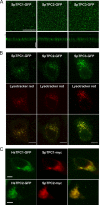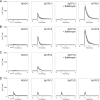An ancestral deuterostome family of two-pore channels mediates nicotinic acid adenine dinucleotide phosphate-dependent calcium release from acidic organelles
- PMID: 19940116
- PMCID: PMC2823445
- DOI: 10.1074/jbc.C109.081943
An ancestral deuterostome family of two-pore channels mediates nicotinic acid adenine dinucleotide phosphate-dependent calcium release from acidic organelles
Abstract
Nicotinic acid adenine dinucleotide phosphate (NAADP) is a potent and widespread calcium-mobilizing messenger, the properties of which have been most extensively described in sea urchin eggs. The molecular basis for calcium release by NAADP, however, is not clear and subject to controversy. Recent studies have provided evidence that members of the two-pore channel (TPC) family in mammals are the long sought after target channels for NAADP. Here, we show that the TPC3 gene, which has yet to be functionally characterized, is present throughout the deuterostome lineage but is a pseudogene in humans and other primates. We report the molecular cloning of the complete ancestral TPC gene family from the sea urchin and demonstrate that all three isoforms localize to acidic organelles to mediate NAADP-dependent calcium release. Our data highlight the functional divergence of this novel gene family during deuterostome evolution and provide further evidence that NAADP mediates calcium release from acidic stores through activation of TPCs.
Figures



Similar articles
-
TPCs: Endolysosomal channels for Ca2+ mobilization from acidic organelles triggered by NAADP.FEBS Lett. 2010 May 17;584(10):1966-74. doi: 10.1016/j.febslet.2010.02.028. Epub 2010 Feb 14. FEBS Lett. 2010. PMID: 20159015 Free PMC article. Review.
-
Integration of nicotinic acid adenine dinucleotide phosphate (NAADP)-dependent calcium signalling.J Physiol. 2018 Jul;596(14):2735-2743. doi: 10.1113/JP275974. Epub 2018 Apr 26. J Physiol. 2018. PMID: 29635794 Free PMC article. Review.
-
The two-pore channel TPCN2 mediates NAADP-dependent Ca(2+)-release from lysosomal stores.Pflugers Arch. 2009 Sep;458(5):891-9. doi: 10.1007/s00424-009-0690-y. Epub 2009 Jun 26. Pflugers Arch. 2009. PMID: 19557428 Free PMC article.
-
Photoaffinity labeling of high affinity nicotinic acid adenine dinucleotide phosphate (NAADP)-binding proteins in sea urchin egg.J Biol Chem. 2012 Jan 20;287(4):2308-15. doi: 10.1074/jbc.M111.306563. Epub 2011 Nov 23. J Biol Chem. 2012. PMID: 22117077 Free PMC article.
-
NAADP on target.Adv Exp Med Biol. 2012;740:325-47. doi: 10.1007/978-94-007-2888-2_14. Adv Exp Med Biol. 2012. PMID: 22453949 Review.
Cited by
-
Bradycardic effects mediated by activation of G protein-coupled estrogen receptor in rat nucleus ambiguus.Exp Physiol. 2013 Mar;98(3):679-91. doi: 10.1113/expphysiol.2012.069377. Epub 2012 Oct 26. Exp Physiol. 2013. PMID: 23104934 Free PMC article.
-
TPC Functions in the Immune System.Handb Exp Pharmacol. 2023;278:71-92. doi: 10.1007/164_2022_634. Handb Exp Pharmacol. 2023. PMID: 36639434
-
Organelle-specific subunit interactions of the vertebrate two-pore channel family.J Biol Chem. 2015 Jan 9;290(2):1086-95. doi: 10.1074/jbc.M114.610493. Epub 2014 Dec 1. J Biol Chem. 2015. PMID: 25451935 Free PMC article.
-
Endolysosomal transient receptor potential mucolipins and two-pore channels: implications for cancer immunity.Front Immunol. 2024 May 22;15:1389194. doi: 10.3389/fimmu.2024.1389194. eCollection 2024. Front Immunol. 2024. PMID: 38840905 Free PMC article. Review.
-
TPCs: Endolysosomal channels for Ca2+ mobilization from acidic organelles triggered by NAADP.FEBS Lett. 2010 May 17;584(10):1966-74. doi: 10.1016/j.febslet.2010.02.028. Epub 2010 Feb 14. FEBS Lett. 2010. PMID: 20159015 Free PMC article. Review.
References
-
- Berridge M. J., Lipp P., Bootman M. D. (2000) Nat. Rev. Mol. Cell Biol. 1, 11–21 - PubMed
-
- Lee H. C. (2001) Annu. Rev. Pharmacol. Toxicol. 41, 317–345 - PubMed
-
- Guse A. H., Lee H. C. (2008) Sci. Signal. 1, re10. - PubMed
-
- Lee H. C., Aarhus R. (1995) J. Biol. Chem. 270, 2152–2157 - PubMed
-
- Galione A., Patel S., Churchill G. C. (2000) Biol. Cell 92, 197–204 - PubMed
Publication types
MeSH terms
Substances
Associated data
- Actions
- Actions
- Actions
Grants and funding
- BB/D018110/1/BB_/Biotechnology and Biological Sciences Research Council/United Kingdom
- HL 090804-01A2S109/HL/NHLBI NIH HHS/United States
- HL 090804/HL/NHLBI NIH HHS/United States
- BB/G013721/1/BB_/Biotechnology and Biological Sciences Research Council/United Kingdom
- GM088790/GM/NIGMS NIH HHS/United States
LinkOut - more resources
Full Text Sources
Miscellaneous

